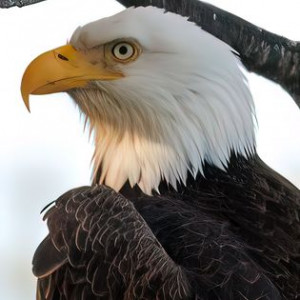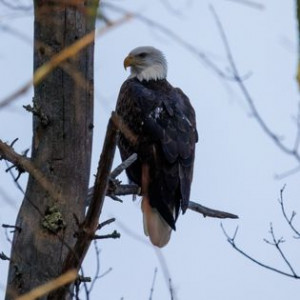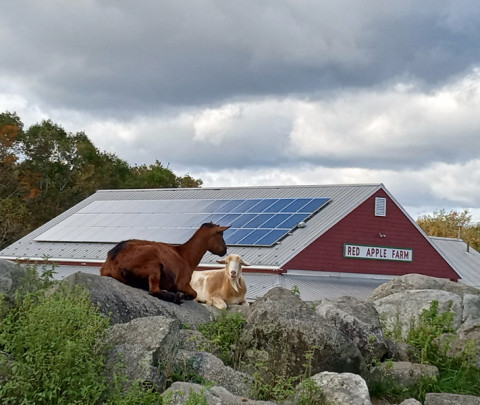Eagle Eyes
- Visit North Central
Our American Icon is a Comeback Story

Look up! That impressive silhouette you see against the bright blue sky just might be an American classic: a majestic Bald Eagle!
Once a rare sight in Massachusetts, bald eagles have made a remarkable comeback — thanks in large part to the Massachusetts Division of Fisheries and Wildlife and other conservation organizations. According to MassWildlife, “from the 1940s until it was banned in 1972, the pesticide DDT caused egg mortality and further decline of the bald eagle.
“Restoration of the bald eagle in Massachusetts began in the 1980s, when MassWildlife and other partners transported young eaglets from wild nests (mostly from Canada) and raised them in cages overlooking the Quabbin Reservoir. Once the birds were ready to fledge, the cage doors were opened and the eagles released,” the state website explains. From the 1990s until 2003, releases of captive-born eagles continued, and now the impressive birds can be spotted throughout the state — including right here in North Central Massachusetts!
Pepperell photographer Norman Bedard has been watching and photographing bald eagles around his hometown for several years, and has come to recognize individual birds (and their mates) as they sail over water bodies like Townsend Harbor and the Nashua River. “There has been a real influx of eagles around this area,” Bedard says, noting that one local farmer reports having seen as many as 20 gathering over the winter.
It may surprise you to hear that winter is a great time to spot bald eagles — but MassWildlife says that winter bird-watchers have a great chance to see the impressive birds. The trick is knowing where to look. “Bald eagles usually live in coastal areas, estuaries, and larger inland waters. They need a lot of shoreline habitat with forested areas for nesting. They prefer areas where some trees project above the forest canopy for perching with an unimpeded view. Bald eagles typically choose waterbodies with a good supply of moderate- to large-sized fish,” according to the MassWildlife website.
Bedard says one of his favorite spots for eagle photography is around Townsend Harbor, right off Main Street (Route 119) in Townsend. “I’ve been able to photograph five eagles at one time, two adults and some immatures (eaglets) near the MassWildlife area on the Squannacook River,” and has photographed eagles with their babies in nests in the area, he says. Bring your binoculars, and you might be able to spot some parents soaring high above their learning-to-fly offspring, keeping an eagle eye on the youngsters.
You can stretch your legs and do a little bird-watching at the same time, following a trail in the Marion Stoddard Conservation Area in Pepperell. Prefer a different view? Drop a canoe or kayak at the launch site in the conservation area named after the local resident who has spent half a century protecting the Nashua River and area environment, and enjoy a leisurely paddle on that waterway.
The best times to spot these huge birds are evening and early morning, Bedard suggests. “They seem to be most active early in the morning, and again toward sundown.”
That is, of course, just one area in which these majestic birds have been spotted. Local residents have also enjoyed watching them, for example, around Lake Shirley in Lunenburg, Wachusett Reservoir in the Clinton/Sterling area, and in the skies over Westminster and Fitchburg.
What are those eagles doing all winter, here in chilly climes? MassWildlife notes that “courtship takes place in mid- to late winter. After courtship, a mated pair builds or adds to a large nest in December–February. The nest is built with large sticks and lined with sprigs of pine, grasses, and other soft materials. Male eagles collect the nest materials and deliver them to their mates, which are responsible for most of the actual nest construction. Once a nesting site is chosen, mated pairs usually return every year and add to the existing nest. Egg laying usually takes place from early March to early April.”
If you see a bald eagle carrying sticks to a nest this winter, MassWildlife asks that you report your observation at mass.wildlife@mass.gov, including the location and date of the observation and your contact information. These observations help MassWildlife identify new nest locations and monitor the eagle population.
Looking for something different to do this winter? Get out and look to the skies!

Fun Facts About Eagles
- The bald eagle is the largest nesting bird of prey in Massachusetts, with a wingspan of at least 6 feet, sometimes more than 7 feet.
- In the wild, bald eagles may live 20 years or more. The oldest wild individual on record lived 38 years.
- The eagle first appeared as an American symbol on one of the first U.S. coins, a copper piece minted in Massachusetts in 1776. The bald eagle became our national bird in 1782.








